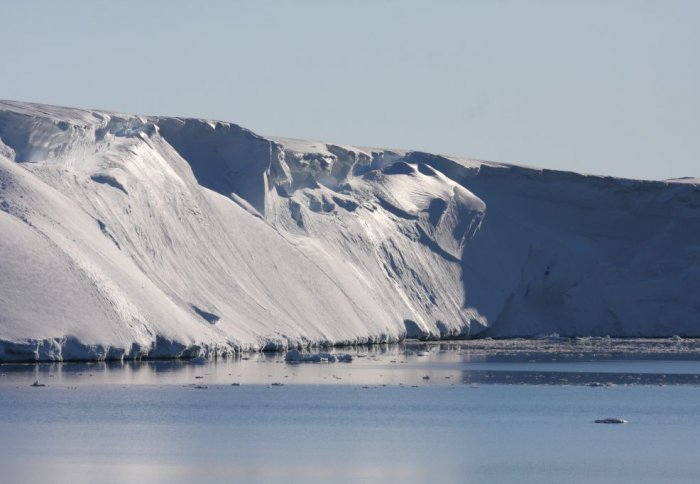
Totten Glacier. Credit: Esmee van Wijk/Australian Antarctic Division

Current rates of climate change could trigger instability in a major Antarctic glacier, ultimately leading to more than 2m of sea-level rise.
This is the conclusion of a new study looking at the future of Totten Glacier, a significant glacier in Antarctica. Totten Glacier drains one of the world’s largest areas of ice, on the East Antarctic Ice Sheet (EAIS).
The evidence coming together is painting a picture of East Antarctica being much more vulnerable to a warming environment than we thought.
– Professor Martin Siegert
By studying the history of Totten’s advances and retreats, researchers have discovered that if climate change continues unabated, the glacier could cross a critical threshold within the next century, entering an irreversible period of very rapid retreat.
This would cause it to withdraw up to 300 kilometres inland in the following centuries and release vast quantities of water, contributing up to 2.9 metres to global sea-level rise.
The EAIS is currently thought to be relatively stable in the face of global warming compared with the much smaller ice sheet in West Antarctica, but Totten Glacier is bucking the trend by losing substantial amounts of ice. The new research reveals that Totten Glacier may be even more vulnerable than previously thought.
The study, by scientists from Imperial College London and institutions in Australia, the US, and New Zealand is published today in Nature. Last year, the team discovered that there is currently warm water circulating underneath a floating portion of the glacier that is causing more melting than might have been expected.
Triggering rapid retreat
Their new research looks at the underlying geology of the glacier and reveals that if it retreats another 100-150km, its front will be sitting on an unstable bed and this could trigger a period of rapid retreat for the glacier. This would cause it to withdraw nearly 300km inland from its current front at the coast.
Retreating the full 300km inland may take several hundred years, according to co-author Professor Martin Siegert, Co-Director of the Grantham Institute at Imperial College London. However, once the glacier crosses the threshold into the unstable region, the melting will be unstoppable – at least until it has retreated to the point where the geology becomes more stable again.
 “The evidence coming together is painting a picture of East Antarctica being much more vulnerable to a warming environment than we thought,” he said. “This is something we should worry about. Totten Glacier is losing ice now, and the warm ocean water that is causing this loss has the potential to also push the glacier back to an unstable place.”
“The evidence coming together is painting a picture of East Antarctica being much more vulnerable to a warming environment than we thought,” he said. “This is something we should worry about. Totten Glacier is losing ice now, and the warm ocean water that is causing this loss has the potential to also push the glacier back to an unstable place.”
“Totten Glacier is only one outlet for the ice of the East Antarctic Ice Sheet, but it could have a huge impact. The East Antarctic Ice Sheet is by far the largest mass of ice on Earth, so any small changes have a big influence globally.”
To uncover the history of Totten Glacier’s movements, the team looked at the sedimentary rocks below the glacier using airborne geophysical surveys. From the geological record, influenced by the erosion by ice above, they were able to understand the history of the glacier stretching back millions of years.
They found that the glacier has retreated more quickly over certain ‘unstable’ regions in the past. Based on this evidence, the scientists believe that when the glacier hits these regions again we will see the same pattern of rapid retreat.
Minimising impact
Researchers at Imperial are looking into the extent to which melting Antarctic ice could affect sea levels around the world, and what technologies could reduce the impact on coastal and low-lying countries.
Meanwhile, Grantham Institute experts are investigating how global warming could be kept to a minimum by reducing the emission of greenhouse gases from fossil fuel power, heavy industry, transport and peoples' energy consumption at home.
-
'Repeated large-scale retreat and advance of Totten Glacier indicated by inland bed erosion' by A. R. A. Aitken, J. L. Roberts, T.D. van Ommen, D. A. Young, N. R. Golledge, J. S. Greenbaum, D. D. Blankenship & M. J. Siegert is published in Nature.
Article text (excluding photos or graphics) available under an Attribution-NonCommercial-ShareAlike Creative Commons license.
Photos and graphics subject to third party copyright used with permission or © Imperial College London.
Reporter
Hayley Dunning
Communications Division

Contact details
Email: press.office@imperial.ac.uk
Show all stories by this author




Leave a comment
Your comment may be published, displaying your name as you provide it, unless you request otherwise. Your contact details will never be published.